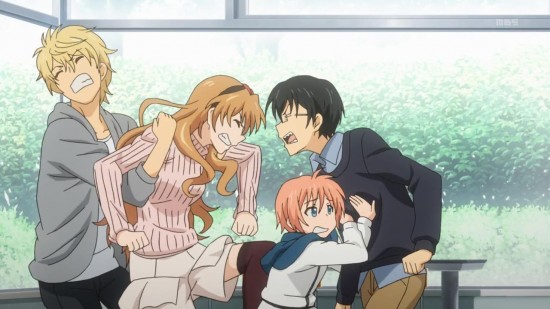Golden Time (Crunchyroll) left me with mixed feelings. Technically it’s very well-executed. It’s offbeat and often quite amusing. But…parts of it were rather unpleasant to watch.

Now this may turn out to be one of those series that I initially react badly to, but which I end up liking much more after I have had time to rewatch and think about them. Part of the trouble may have been my expectations. I thought of this as a “romantic comedy,” but really the story is more about how the hero deals with his amnesia, presented with a lot of Buddhist ideas about the nature of the “self.” Not your standard rom-com fare.

When we first meet the hero Banri he seems awkward and unsure of himself, but we quickly learn that he is brave and resourceful, not to mention unfailingly loyal to his friends. In other words, the sort of person you would probably like to have as a friend.
But we gradually learn that he has only been like this since the accident that cost him his memory. We see in flashbacks that before the accident he was an annoying whiny self-pitying little wimp.

So here’s the main problem: as Banri’s memories start to return he starts to act more and more like his annoying older self. That isn’t pleasant to watch.

Then there’s Kouko, the other romantic lead. She’s certainly beautiful but her personality leaves a lot to be desired. She’s not entirely unsympathetic. She means well; she sets high standards for herself and she’s her own worst critic. But she’s a spoiled princess who grew up believing that if she was a good girl she would automatically get whatever she wanted. When frustrated she tends to lash out in ways that are often hurtful and sometimes violent.

So it’s a match made in Hell, right? But we’re probably dealing to some extent with a clash of cultural expectations. American romantic comedies usually start with two very attractive people who are obviously (from the audience’s viewpoint) perfect for each other. All of the dramatic tension is in how long it will take them to figure that out.

Japanese romantic comedies, at least of the seinen and josei varieties, tend to take a different approach. They typically involve obviously flawed people who gradually build a relationship over a long period. For example in the classic Maison Ikkoku the hero started out as an annoying, self-defeating loser. The heroine thought of herself as a traditional sweet and deferential Japanese woman, but actually she was quick-tempered and always had to have her own way. It took a very long time but eventually the two of them built a mutually-satisfactory and fairly believable relationship.

Golden Time makes things more difficult because it goes beyond the realm of mere personality quirks and into the area of actual mental illness. (Multiple Personality Disorder at the very least.) That doesn’t necessarily make it a bad story, but it’s not something I can enjoy as light entertainment. And does it have the gravitas to deal with more serious themes? I’m still not sure. Ask me in a few months after it has had time to sink in.
But I want to stop here and praise the studio for the quality of its execution. Generally I think of J.C. Staff as a studio whose animation is adequate but not outstanding. (Or occasionally, as with Little Busters, they do animation that is really pretty bad.)
The animation in Golden Time doesn’t seem all that special at first glance. It was obviously done with some budget constraints. We don’t see the spectacular tracking shots and splashing water that are the trademark of Kyoto Animation. But each scene in its own low-key way feels emotionally perfect and the attention to detail is sometimes amazing. Consider, for example, the red dress with the flower pattern that Kouko wears in the second picture above.

Or consider the patterned yukata that she wears in a later party scene. What’s so special about that? Don’t Japanese traditional clothes almost always have a pattern? Not in anime they don’t, because animating the movement of patterned cloth is very very hard.

In anime people almost always wear solid colors, even if they are supposed to be aristocrats in court dress. (Or, much worse, sometimes a woman wears a kimono with a complex pattern, but when the character moves the pattern stands still. That looks dreadful.)

So, whether you like this story or not, at least the people who made it cared a lot about it and put a lot of effort into telling it.

